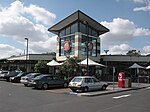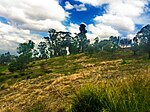St Bartholomew's Anglican Church and Cemetery, Prospect
1840 establishments in AustraliaAnglican cemeteries in AustraliaCemeteries in SydneyChurches completed in 1840Churches listed on the New South Wales State Heritage Register ... and 6 more
Churchyards in New South WalesFormer Anglican church buildings in SydneyGeorgian Revival architecture in AustraliaProspect, New South WalesUse Australian English from June 2018Victorian architecture in Sydney

St Bartholomew's Anglican Church and Cemetery is a heritage-listed former Anglican church and cemetery at Ponds Road, Prospect, City of Blacktown, New South Wales, Australia. It was designed by Henry Robertson and built from 1838 to 1840 by James Atkinson. It was added to the New South Wales State Heritage Register on 2 April 1999. Since 1975, the site has been leased to the Council of the City of Blacktown.
Excerpt from the Wikipedia article St Bartholomew's Anglican Church and Cemetery, Prospect (License: CC BY-SA 3.0, Authors, Images).St Bartholomew's Anglican Church and Cemetery, Prospect
Ponds Road, Sydney Prospect
Geographical coordinates (GPS) Address Nearby Places Show on map
Geographical coordinates (GPS)
| Latitude | Longitude |
|---|---|
| N -33.8045 ° | E 150.9176 ° |
Address
St Bartholomew's Church
Ponds Road
2148 Sydney, Prospect
New South Wales, Australia
Open on Google Maps









